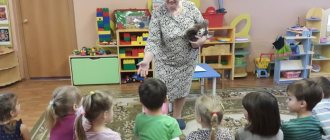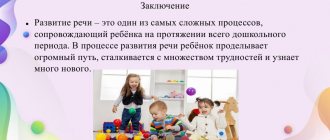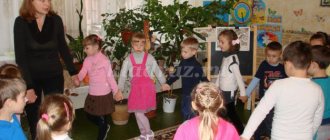Summary of a lesson on the development of coherent speech in the senior group
Summary of a lesson on the development of coherent speech in the senior group with presentation.
Topic: Retelling the fairy tale “The Postal Snail” Purpose: teaching a coherent, sequential retelling of the text based on graphic diagrams depicting the sequence of events. Objectives: 1. Educational:
- introduce the fairy tale “The Postal Snail”;
— learn to compose simple sentences, independently relying on graphic diagrams; - consolidate children’s ideas about the features of a fairy tale, its differences from a story. 2. Developmental:
- continue to develop the ability to listen carefully to a work of art, understand its meaning, and the ability to answer questions posed;
— develop basic mental operations: analysis, synthesis, generalization; - develop monologue speech; - improve coherent speech. 3. Educational:
- to create interest in speech activity;
independence, initiative in solving speech problems; - cultivate a value-based attitude towards literature. Preliminary work : reading fairy tales of other peoples, fairy tales of Russian writers, reading fiction about nature, looking at illustrations depicting flora and fauna, guessing riddles, didactic and outdoor games. Vocabulary work : herbivore, moisture-loving, postman, employees puzzled, valuable envelope, responsible employee. Methods and techniques : 1) Game-based: game motivation, physical education. 2) Verbal: conversations, reading fiction, explanations. 3) Visual: looking at illustrations, pictures. 4) Practical: working with reference diagrams. Equipment : slide show, illustrations for a fairy tale, graphic diagrams for a fairy tale, easel.
Progress of educational activities
1. Org. moment. Educator: - Look guys, we have guests today, let's say hello to them. — What’s your mood today? (children's answers) - I am also in a good, joyful mood today. Greeting game Gentle, kind girls! Strong, brave boys! Let's stand in a circle and let's all hold hands and smile joyfully at each other! Educator : - Let us smile and give our mood to everyone who surrounds us. 2. Motivational – orientation stage. Educator: - Today I invite you to go to the wonderful world of animals. Where we have to discover the most interesting secrets of animal life, their most unusual features and learn a lot of new things. And today we will talk... And about whom, you will find out if you guess my riddle: The house is always his own, Even goes to visit in it... There are horns, but not butts, Who sticks to the palm? (Snail) 1 slide - What does a snail eat?
Educator : - The snail is a herbivore. What does it mean? Herbivore means it eats grass and other plants and vegetables. Slide 2 - How does a snail eat?
Educator: - On the snail’s tongue, like on a file, there are hundreds of small teeth, with which the snail cuts and grinds food. Slide 3 - How does a snail live?
Educator: - Moisture-loving - this means she loves moisture. In dry weather, the snail hides under stones, in the shade of plants or in damp moss. Usually it spends the day hiding in its shell and comes out to feed at night. The snail is most active at night or after a rainstorm. Slide 4 - How does a snail move?
]
Educator: - The snail moves very slowly. Let’s all try to say the following words together: “Snail, crawl a little on your leg!” (Children say these words in chorus.) Look, while we were talking, the snail managed to crawl this distance. (Showing a segment 1.5 cm long). Slide 5 - Why does a snail need horns?
Educator: - A snail doesn’t just have horns, but one pair of horns, one pair of antennae. The antennae are small, the snail sniffs them. And the big horns are eyes. Both the horns and antennae of snails are very sensitive: if they accidentally touch any object, the snail immediately removes them inside. - That's how much we learned about the life of a snail. 3. Search stage Educator: - Guys, I want to tell you one interesting fairy tale, sit down more comfortably, take a listening position, so.... Reading the fairy tale “The Postal Snail.” More than anything else, the snail wanted to be a postman. “How wonderful it is,” she thought, “to spread good news and deliver valuable packages! Being a postman is the most interesting, most important and most joyful job!” But the postmen did not take the snail. You probably already guessed why: she crawled very slowly. - How will you spread the news? – laughed at the little girl at the post office. -Snails are not accepted as postmen. By the time you reach the recipient, the news will be outdated! This will no longer be news, but some kind of “old age”! Who will need them? “Eh,” sighed the snail, “why wasn’t I born a hare or a dove? Then no one would laugh, they would immediately accept it! I wish I could be as fast as them!” And she decided to train to become faster. Every morning the little girl woke up in the dark and went for a run. By dawn she was already on the treadmill. And by lunchtime she had crawled as much as two meters! Then two meters and a little more... But, alas, no matter how hard she tried, she remained a little fast, but still a snail. And she was still unsuited to work at the post office. - Give up this idea! - the hare shouted, adjusting his bag filled with letters and magazines as he ran. - You're just wasting your time. Even the fastest snail in the world cannot work as a postman! The snail understood that he was right, but she still couldn’t give up her dream. But one day a letter with a special note arrived in the mail. “Dear postman,” it was written on the envelope, “please be careful with this letter: it is full of tender feelings and may be damaged.” The postal employees were puzzled. Who can you trust to deliver such a valuable envelope? What if the hare remembers tender feelings? Or will they be damaged by shaking? - Snail! – the magpie suddenly remembered. - This is who can cope with such a task! True, she will not be able to deliver tender feelings quickly, but they will arrive safe and sound! And everyone agreed that it would be better this way. The snail tried really hard! And, of course, she did it! Now the little girl works at the post office and is very happy. When something needs to be delivered very carefully and accurately, they trust the snail. And everyone is very proud that they have such a responsible employee! (material from the Internet) Work on content. Educator: - Guys, did you listen to the fairy tale carefully? (Children's answers). - Let's talk to you about the content of this fairy tale. We answer with a full sentence. - Tell me, who is this fairy tale about? (Children's answers) - Who did the snail want to be? — Why did she like the profession of a postman? — Why didn’t the postal employees take the snail to work? - What efforts did the snail make to become fast? — What did the hare advise the snail? - What happened next? (Children’s answers) - What do you mean “the employees are puzzled”? (Children's answers) The teacher gives a definition of the expression. - “Puzzled” means to find yourself in a difficult situation, difficulty with an answer. - What did the magpie suggest? — What does “responsible employee” mean? The teacher gives a definition of the expression. - “Responsible worker” means one who does the job carefully, perfectly. Educator: - And now I invite you to a snail walk. Physical education A snail crawls along the path. It carries its house on its back. He crawls quietly, in no hurry, always looking around. Well, when she gets very tired and wants to rest, she can quickly curl up and turn into a round ball. Re-reading a fairy tale. Educator: - I will read the fairy tale to you again, you listen carefully, then we will retell it. And I will read the fairy tale based on the diagrams. The teacher displays diagrams while reading. 4. Practical stage. Retelling a fairy tale with the support of a diagram (you can use a presentation) Educator: - Guys, it’s difficult to retell such a big fairy tale alone. And if you break the text into parts, the tale can be retold by three people, even four people. Retelling a fairy tale based on diagrams (chain by part) . Educator: - Guys, please, who wants to tell you about the diagrams? What will you call your story? (calls 4 children to the easel, then 4 more children) - How would you title this fairy tale? OOD analysis. Educator: - What fairy tale did you get acquainted with today? — What do you remember most from the fairy tale? Individual analysis of children's activities in the classroom. 5. Reflective-evaluative stage. -Who was the hero of our lesson?
— What did you learn new there? - Next time we will introduce you to another good and instructive fairy tale. Presentation on the topic: Postal snail
We recommend watching:
Notes for a lesson on speech development in the senior group: Special purpose transport Notes for a lesson on speech development for children in the senior group of preschool educational institutions Notes for the development of speech in the senior group “Wild Animals of Russia” Notes for a lesson on speech development in the senior group. Nosov "Gardeners"
Similar articles:
Summary of a lesson on speech development in the senior group. Compiling a descriptive story based on a painting
Summary of a lesson on speech development in the senior group. Reading works of fiction
Summary of a lesson on speech development in the senior group. Retelling of a work of art. Charushin "Sparrow"
Summary of a lesson on ecology in the senior group of kindergarten on the topic “Man and Nature”
Lesson on emotional development in the senior group
Summary of an open lesson on speech development in the middle group “Once upon a time there were fairy tales”
And she planted the seed of kindness.
Supporting diagrams for classes on speech development for children speech development
Fairy tale "The Ryaba Hen"
Fairy tale "Three Bears"
Self-analysis of an open lesson on speech development
in the middle group “Once upon a time there were fairy tales.”
Dear Colleagues! We present to your attention classes on speech development in the middle group “Once upon a time there were fairy tales.”
Goal: to develop children’s cognitive and speech skills using their favorite fairy tales as an example.
When developing the outline, I took into account the program requirements and age characteristics of children in the middle group.
To achieve this goal, I set the following tasks:
— To consolidate children’s knowledge about Russian folk tales.
— Continue to develop coherent speech, correctly coordinate words in a sentence.
— Develop attention, memory, logical thinking, creative imagination.
— Enrich children’s vocabulary with words: “fidgety,” “minx,” “lazy,” “fluffy,” “nimble,” etc.
— Cultivate interest in Russian folk tales
Preliminary work:
1. Look at illustrations for fairy tales.
2. Making riddles about fairy tales.
4. Showing the fairy tale “The Three Bears” (On a magnetic board).
This lesson was developed taking into account modern requirements (FSES DO, SanPin)
. The duration of the NOD corresponded to hygienic standards for children of this age. Frequent changes of activities throughout the activity allowed the children to avoid fatigue.
In its structure, direct educational activities are built on a single game plot in order to arouse and maintain the cognitive interest of children. Consists of 3 interconnected parts: introductory, main and final.
The water part of the educational activity itself involved organizing children: creating an emotional mood, setting for the upcoming activity, switching attention to the upcoming activity, stimulating interest in it. It was done with a greeting, a surprise moment.
The main part of ECD is aimed at independent mental and practical activity, fulfilling all assigned tasks.
The main part of the GCD included tasks for repeating the studied material (composing fairy tales according to diagrams; here I tried to get complete, clear answers from the children to the questions asked. The children actively answered).
A magnetic board was used to compose the tale “The Three Bears”. Here the children independently composed a fairy tale based on cut and mixed up pictures.
In the final part, summing up the lesson, I involved the children in this and asked them to speak on the topic: What did you like most about the lesson?





